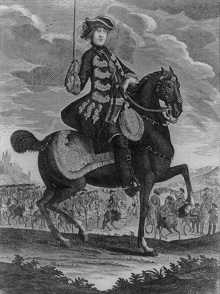The Canadian invasion never materialized. As Lafayette speculated, the entire proposal was primarily a distraction with the objective of removing those loyal to Washington. In March 1778, Congress passed the following resolution on behalf of Lafayette's service:
"That Congress entertain a high sense of his prudence, activity, and zeal and that they are fully persuaded nothing has or would have been wanting on his part, or on the part of the officers who accompanied him, to give the expedition the utmost possible effect.
Lafayette returned to Valley Forge early in April 1778. The conspiracy to displace Washington had failed. Lafayette remained at Valley Forge, improving his knowledge of military tactics, until Washington marched out of Valley Forge to meet the enemy in New Jersey.
The British evacuated Philadelphia on June 19, 1778. Washington pursued the fleeing enemy across across New Jersey. Washington called a council of war at Hopewell, New Jersey to discuss strategy with his generals.

Charles Lee
Engraved by Johann Michael Probst
circa 1776-1790
LOC id:cph.3a45386
Charles Lee favored a policy of small targetted attacks and harassment. Anthony Wayne, Nathanael Greene and Lafayette proposed a more aggressive campaign, beginning with a major offensive on the rear of the enemy. Washington accepted this plan, offering the command to General Lee but Lee was certain the plan would result in disaster. Lafayette requested command of the advanced position, and Lee was happy to oblige, as he was convinced that defeat was inevitable.
But Lee changed his mind, deciding that he wanted to command the perhaps not-so-hopeless expedition after all. He wrote to Washington on June 25, 1778:
When I first assented to the Marquis of Fayette's taking the command of the present detachment, I confess I viewd it in a very different light than I do at present. I considerd it as a more proper business of a Young Volunteering General than of the Second in command in the Army-but I find that it is considerd in a different manner . . . I must intreat therefore, (after making a thoushand apologies for the trouble my rash assent has occasion'd to you) that if this detachment does march that I may have the command of it.
Washington acquiesced to the mercurial General's change of heart, writing to Lafayette the following day:
General Lee's uneasiness on account of yesterday's transaction rather increasing than abating, and your politeness in wishing to ease him of it, has induced me to detach him from this Army, with a part of it, to reinforce, or at least cover, the several detachments under your command, at present. At the same time that I felt for General Lee's distress of mind, I have had an eye to your wishes, and the delicacy of your situation; and have, therefore, obtained a promise from him, that when he gives you notice of his approach and command, he will request you to prosecute any plan you may have already concerted for the purpose of attacking or otherwise annoying the Enemy. This is the only expedient I could think of to answer both your views. General Lee seems satisfied with the measure, and I wish it may prove agreable to you
The Battle of Monmouth: June 28, 1778
On June 28, the American and British forces clashed at Monmouth Courthouse, in central New Jersey. Lafayette perfomed ably. Lee, in command, did not. His troops were in disarray and in retreat. Washington managed to rally the American troops, relieving Lee of his command and placing many of his former troops under Lafayette's command. The Americans salvaged a partial victory from near defeat. The British managed to escape to New York, but lost their foothold in New Jersey and suffered heavier casualties than the Americans. Many on both sides died of heat-stroke during the blisteringly hot battle. Lee was later court-martialled and found guilty on three charges for his dismal performance.
On July 8, the French fleet arrived under command of Admiral d'Estaing. Washington planned to use the French naval forces as part of a coordinated attack by land and sea on British-held Newport, Rhode Island, sending Greene and Lafayette with 3,000 troops to serve under command of General John Sullivan. On August 10, the French and British naval forces clashed, but a severe storm damaged both fleets. The Americans on the ground could not launch an attack without the French naval support, the absence of which prompted many of the Americans to desert. D'Estaing brought his damaged fleet to Boston for repairs. Lafayette rode to Boston to plead with his countryman to bring the fleet back to the siege of Newport, but d'Estaing remained unpersuaded
By the time Lafayette returned to Rhode Island, the siege had ended and the British had attacked the withdrawing American forces. Lafayette was instrumental in commanding troops during the strategic withdrawal. On September 9, 1778, Congress officially commended Lafayette, resolving:
That the President be requested to inform the Marquis de Lafayette, that Congress have a due sense of the sacrifice he made of his personal feelings in taking a journey to Boston with a view of promoting the interest of these states, at a time when an occasion was daily expected of his acquiring glory in the field, and that his gallantry in going on Rhode Island, when the greatest part of the army had retreated, and his good conduct in bringing off the pickets and out- sentries, deserve their particular approbation.




